INTEGRATED EXERCISES
Alternate Sword/Shield/Step
| |

Figure 17a |
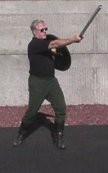
Figure 17b |
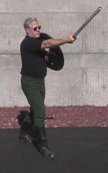
Figure 17c |
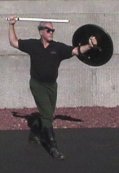
Figure 17d |
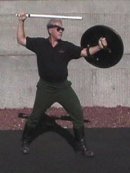
Figure 17e |
|
This exercise is useful when teaching a student:
- To focus power in both their strikes and their blocks
- To utilize proper technique when performing the punch block, and returning the shield after the block.
-
The exercise is performed using a sword and shield, and consists of four separate actions, sequentially performed as the student moves forward.
The keys in this exercise are proper technique, overemphasis on power and focus, and isolation of the techniques.
To start the exercise, take a fighting stance with sword and shield, (Please see Figure 17a, above.) as described previously. The steps of the exercise are as follows:
1. Execute a high forehand strike towards the head of an imaginary opponent. Please see Figure 17b, above.
- At the same time, pull in your shield towards your shield shoulder, keeping it high. Move so that if you did not have a shield, the extended fingertips of your shield hand would touch your collarbone at the farthest back point.
- Try to make the forehand strike as focused as possible, moving the sword hand directly towards the target.
- Insure that your front knee bends, and that your weight moves slightly forward to accentuate the power of the blow.
- Do not swing full force. The movements should be crisp and quick, but swing too hard will injure your arm.
- The sword should remain extended, and the shield should remain pulled back until step 3.
2. Take a step with your sword foot. Please see Figure 17c, above.
- Keep your feet moving on separate, parallel lines. Do not allow them to cross.
- When moving your foot forward, first shift your balance to the shield foot, while moving your sword foot forward and towards your shield foot.
- Then continue forward and out with your sword foot in a manner similar to the Power Pushing exercise.
3. Perform a punch block accompanied by an overhead return. Please see Figure 17d, above.
- At this time, the shield foot will be back. This allows the student to accentuate the hip rotation with a leg thrust when applying power.
- I find it useful to have the student first "cock" their shield hip by rotating it slightly back. This further emphasizes the power application. This is useful as part of the exercise, but do not do it in combat.
- Insure that your front knee bends, and that your weight moves slightly forward to accentuate the power of the block.
- The shield should remain extended, and the sword should remain pulled back in the overhead return until step 1 is repeated.
4. Take a step with the shield foot. Please see Figure 17e, above.
- Keep your feet moving on separate, parallel lines. Do not allow them to cross.
- When moving your foot forward, first shift your balance to the sword foot, while moving your shield foot forward and towards your sword foot.
- Then continue forward and out with your shield foot in a manner similar to the Power Pushing exercise.
The steps are then repeated. Subsequent strikes are performed with the sword starting from the overhead return position. (See description, above.) Do not return the sword to the sword shoulder at any point. Subsequent shield returns are performed with the shield starting in the extended block position.
Aside from incorrect technique, the most frequent errors are:
- Straightening the front leg when performing the blocks and strikes
- Dropping the shield lower when returning it after blocks
- Striking at a lower target than eye-level
- Not coming to a motionless "set" position between the steps
Once the exercise is mastered, it can be useful to perform it while taking backward instead of forward steps. Be careful to insure that the student is in a proper stance after each step before continuing.
Two-on-One
This is a very useful exercise, and it provides an opportunity to practice many things:
- Power application footwork
- Target acquisition.
- Punch blocks and overhead returns
- Integration of all the other points.
The exercise requires two assistants, along with the student being trained. All should have swords and shields. The starting position is best described mapped onto a marked parking space in a parking lot.
- Have the student being trained assume an "on-guard" position at the end of the parking space, centered between the lines.
- Have the two trainers about two feet in front of the student, but outside of the lines. This should be a very flat isosceles triangle.
-
These are two views of the movements of the person being trained in the 2-on-1 exercise. In the actual exercise, there would be two other people – one swinging a sword from the fighter’s right, and the other holding a shield to be hit, on the fighter’s left.
In general, the student will proceed forward in a "herringbone" pattern of steps (similar to the motions of a speed skater). The student will strike at the shield of the trainer on the left, and block the strikes delivered by the trainer on the right. The trainers maintain their position relative to the student as he or she moves forward. As the exercise is mastered, the speed can be varied.
To perform the exercise:
- Assume the starting position as described, above.
- The student should take a sliding step with the shield foot, forward and sideways towards the trainer on the left.
- At the same time, deliver a forehand strike towards shield of the trainer.
- The trainer should keep a relative position such that their shield is in range, but they are not.
- The student should have oriented his or her body and direction of movement towards the trainer.
- At the same time, the student should pull in his or her shield, not allowing it to drop down, and keeping it tight against their upper, left chest. The top edge should be very close to the student's chin.
- As soon as the strike hits, the student should look towards the trainer on the right, focusing on the trainer's sword hand.
- At nearly the same time, the student's weight should be transferred to the shield foot, while the sword foot is brought forward and in towards the shield foot.
- The motion of the sword foot should continue in an arc forward and out towards the trainer on the right.
- At the same time, the student should execute a punch block to the sword of the trainer on the right.
- The student should have oriented his or her body and direction of movement towards the trainer on the right.
- At the same time, the student should execute an overhead return.
- (The trainer on the right should not be swinging fast, or with any power. The idea is to have the sword moving and part way through a strike when the student looks at, and starts to move towards, the trainer on the right. It is the trainer's responsibility not to hit the student.)
- As the execution of the block is completed, the student should look back towards the trainer on the left.
- At nearly the same time, the student's weight should be transferred to the sword foot, while the shield foot is brought forward and in towards the sword foot.
- The motion of the shield foot should continue in an arc forward and out towards the trainer on the left.
- At the same time, the student should be executing a strike towards the shield of the trainer on the left.
- The trainer should keep a relative position such that their shield is in range, but they are not.
- The student should have oriented his or her body and direction of movement towards the trainer on the left.
- At the same time, the student should pull in his or her shield, not allowing it to drop down, and keeping it tight against their upper, left chest. The top edge should be very close to the student's chin.
- Continue to repeat the sequence, above.
The most common problem is that the student will not step towards and orient his or her body towards the trainers on alternate steps. This will result in the student having to reach across their body to perform the blocks and strikes. A lesser problem is that the student will move more towards one trainer than the other. If this occurs, the movement of the exercise will be in a curved line towards one side.
Slow Work
Proper use of slow work is the cornerstone of this teaching system. If done properly, it teaches everything from basic techniques to the esoteric perception/focus arts. If done improperly, it will ruin a fighter's style.
Nearly all learning of techniques takes place during slow work. You should learn slow, polish fast. Polishing before techniques are learned will result in polished errors. Also, many of the descriptions of techniques and exercises in this document are designed for slow practice.
When practicing, it is not sufficient to simply slow the speed of the technique. The motions themselves change when the speed slows, becoming exaggerated and wider. It is necessary to mention this, since students may object that a practice technique would not work in combat because it would place them in a poor position, would move the shield too far back, etc. The answer to this objection is that the slow practice trains muscular action and cooperation, and this requires movements which are exaggerated and wide, since that's what the motions look like when they are done slowly.
Consider the example of cheap, martial arts movies. It is the practice in these movies to speed up the film to make the actors appear faster. It is always possible to tell when this speeding-up is done, since the movements do not look natural. It is always possible to tell when the film has been slowed down, for the same reason. In reality, a technique performed at different speeds is performed with different movements.
The training exercises are attempts to simulate the proper movements of the technique for the speed (slow) at which the greatest learning occurs. Some adjustments must be made when performing at full speed, but not many. The only one that comes to mind is that the position of the shield during sparring must be kept more closely to the front when moving at faster speeds. The motion of the sword naturally moves in closer to the center of rotation (preferably the body) as the speed increases.
- It is absolutely vital that movement during the exercise be very slow, and as uniform as possible, not just for the sword, but for the whole body. There are instances in intermediate and advanced training where faster movement is desirable, but never when learning or perfecting new techniques.
- You should move the sword rather than swing it. In other words, when you stop your hand, the sword should stop. There should be no residual motion that requires stopping.
- The movement should be slow enough that you do not feel especially rushed, even when doing difficult or exaggerated movements.
- The better you get at the exercise, the more time you will seem to have, since your movements are more efficient, and flow together better. The temptation will be to speed up.
- Movements should be exaggerated, and performed with the whole body. Movements tend to move in towards the center of rotation while the sword moves towards its tip when the movement as a whole speeds up. Therefore you must keep your hand higher, farther back, etc during slow work.
- Since there is no momentum to keep the sword moving, you must consciously force it to move through the proper paths.
- Remember, when stepping, move the shield foot while your weight is on the sword foot during a strike. Move the sword foot while your weight is on the shield foot during a return.
- Don't hit hard or push into your strikes. Just barely touch your target, then go immediately into a return technique. This prevents the development of the habit of "posing" when you strike.
- You are responsible for not striking your opponent. If he or she looks away at just the wrong time, it is your job to keep from landing a blow.
- Don't extend the wrist forward at the end of a strike. Keep the wrist rigid, with the sword maintaining its starting position relative to the arm.
- You must strive to keep the techniques "real".
- Don't change the directions of blows in mid swing, if you couldn't do it in full speed.
- Don't step forward with a swing. Stepping before or after is fine, but if you do it at the same time in full speed, your blow won't have any power.
- If you miss, don't stop the blade as if you hit. Continue with the swing, and move into a return.
- Emphasize a backswing. Your return techniques should be exaggerates so that the sword hand moves back as far as possible.
- Don't get caught up in "winning" the slow practice. It is not a fight; it is a practice. You don't have an opponent; you have a partner.
- Again, don't change speeds.
Don't worry about keeping the shield in front of you, or your stance in a proper open/closed position. The idea is to make your body flow with your weapons. It is relatively easy to get things tightened up later.
Without Shield
The emphasis is on rhythm, movement and flow. It is not simply fighting while holding an imaginary shield, but rather fighting without a shield. Don't hold your shield hand in the position in which you would normally hold a shield. Rather you should move it as if you were pulling and pushing your sword, or starting direction changes with your body.
- In the basic and intermediate forms of this exercise, the target of your sword should be the sword of your opponent.
- Swings should alternate from forehand to backhand on every stroke. In the early attempts, you should adhere to a rigid, simple pattern of swings and returns.
- Later, when rhythm and proper movement has been established, the exercise can become more free form. In these later stages, an important objective is to move as much as possible between swings, and to swing from many different positions and angles, but still maintaining the rhythm and the alternation of forehand and backhand strikes.
Rhythm
- Especially in the beginning the emphasis is on performing in a set rhythm. This is to allow you to notice when you are unintentionally varying the speed of your motion.
- Even if your sword strikes are in rhythm, it is a common error to move the sword too fast during part of the swing, and too slow during another. The fast part is usually during the backswing.
- This is often accompanied by an unrealistic change in the direction of the swing.
- Later, in the very advanced version, changing the rhythm is one of the objects of exercise. By then you should know some of the techniques by which you can accomplish this change in a realistic manner.
Movement
- When you move, it is important to coordinate the movement of your upper and lower body.
- The movement of your legs should drive the movements of your body, and both should be coordinated with the motion of your arm and sword.
- Your entire body and sword should move as an entity. It is not enough to simply move slowly with your arm, while the body moves at normal speed.
| |
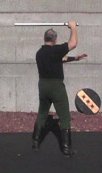
Figure 18a |
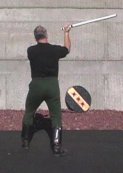
Figure 18b |
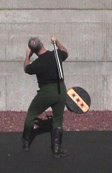
Figure 18c |
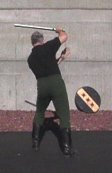
Figure 18d |
|
Blindfolded
- This is a very structured form of slow work. In this form of the exercise, only one partner is trained. The other functions as a trainer.
- Start normal slow work (without shield).
- Once the rhythm has been established, have the person to be trained close his or her eyes while continuing to swing.
- The 'trainer' need not continue to move as if doing slow work. (It is better for his or her own training if it is possible). The responsibility of the trainer is to meet the sword of the trainee, as if regular slow work was still progressing. It is useful to allow a miss from time to time.
Timing/Distance (very advanced)
This type of slow work is more like dancing than fighting. It is performed without shields, but the sword may not be used for blocking. Your partner's swings must be avoided by dodging.
The objective is to execute a strike that would impact on your partner, that he or she could not dodge or avoid, while not being struck at the same time or soon afterwards.
This can be achieved by varying the timing of your swings, and precisely controlling distance. This does not mean that you can swing at different speeds. It means that you must vary the time it takes to complete a backswing and forward swing. This is done by varying the length of the path that the sword follows.
- The movement must be fairly slow, and very controlled.
- Movement must be constant, and at the same speed at all times. Don't ever return your sword to your shoulder during the exercise.
- Don't keep your shield hand in the position to hold a shield. Use it to lead the sword hand through maneuvers.
- Defense is stressed. A double kill is a failed exercise, not a draw.
- Vary the timing of your strikes.
- Stepping away during a backswing lengthens the time between strikes.
- Stepping forward during the forward swing shortens the time between strikes.
- Straightening your arm during the backswing and forward swing lengthens the time between strikes.
- Bending your arm during the backswing and forward swing shortens the time between strikes.
- Remember, when stepping, move the shield foot while your weight is on the sword foot during a strike. Move the sword foot while your weight is on the shield foot during a return.
To start the exercise:
- While in a normal fighting stance, the first partner's sword should be extended at waist level towards the second partner. The shield hand should be back and up.
- While in a normal fighting stance, the second partner should have his or her sword extended up and back. The shield arm should be extended forward and pointing down towards the waist of the first partner.
- The starting distance should be just outside of sword range.
To perform the exercise:
- The second partner executes a strike towards the first partner.
- At the same time, the first partner moves the sword into a return, and moves his or her body to dodge the strike.
- As the tip of the second partner's sword passes in front of him, the first partner's sword should be at the farthest rearward point in a return.
- The first partner continues into a strike towards the second partner.
- At the same time, the second partner moves the sword into a return, and moves his or her body to dodge the strike.
- Repeat the above, with lots of movement.
With Shield
Slow work with a shield can emphasize many things. It is not just slow fighting. It should be used to train different skills at different times. Once the exercise is comfortable, the trainer can have the student concentrate on one of several things, such as using deep returns, keeping the shield up, defense, etc.
Rhythm
Especially at first, fighters should strive for rhythm in this exercise; as in a 1, 2, 3, 4 cadence. This, coupled with the slow movement, allow the fighter time and a framework in which to learn the basic techniques.
Movement
- Once the rhythm is established, and techniques can be performed at a rudimentary level, start the fighters moving around one another.
- At the beginning, just coordinating the feet and hands is hard enough. Emphasize being in a position to supply power to the sword when swinging. Essentially, move the sword foot with the backswing, and adjust the shield foot during the forward swing. This guideline is not hard and fast.
- As the fighter gains proficiency, emphasize movement for the purpose of getting a better angle from which to strike. Remember, when you swing a sword, it can be blocked by a shield moving towards the center of rotation. If all swings come from one place, they become relatively easy to block. If moving and twisting your body can move the center of rotation out to either side, (or perhaps up and down), the swings will be much more difficult to block.
Slot Work
This is a technique that should be incorporated into slow work starting with low-medium skill level, and increasing as the skill level grows. It is basically the practice of aiming for 'slots', or targets unprotected by the shield.
- The more useful slots are those that are difficult to protect at all.
- Refer to the 'butterfly walk' under training techniques.
Note the part about the hand passing through the target.
This is the key. The sword follows the hand, so the hand must move through the slots, and the sword must follow precisely. Once the hand has moved around the space protected by the shield, the sword will generally also avoid the shield.
It is possible to have the sword not precisely follow the hand. This is achieved by moving the sword elbow to the left or right (and up or down) during the strike to cause the angle of the blade to change during the stroke. What is happening is that there is force being applied to the sword in two directions at once. The main force is moving the sword towards the target. The other is rotating it around its center of mass. Neither interferes with the other, but they combine into a different effect that would be possible with either acting along.
|








